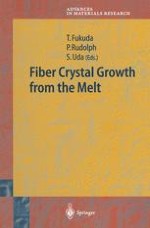Fiber Crystal Growth from the Melt reviews the growth, modelling, characterization and application of single crystal fibers are reviewed. Due to their very large length-to-diameter ratio together with perfect crystallographic structure and chemical homogeneity, such fibers have mechanical and physical properties that approach the theoretical values. Fukuda explains how their ultra-high strength enables their application as reinforcing agents in structural components. And he elucidates how and why fiber crystals are particularly well suited for wave guiding, tunable narrow-band filters and nonlinear optics and for the generation of green, blue and violet wavelenghts, and also as micro lasers and laser modulators. The book is suitable for specialists and students in the fields of materials science, crystal growth, physics, chemistry, crystallography, optics, mechanics and engineering.
